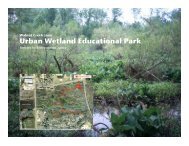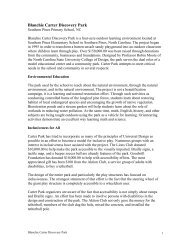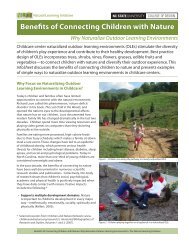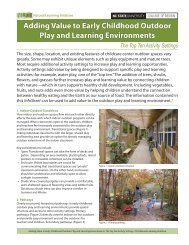LATIS Forum on Therapeutic Gardens - Natural Learning Initiative
LATIS Forum on Therapeutic Gardens - Natural Learning Initiative
LATIS Forum on Therapeutic Gardens - Natural Learning Initiative
You also want an ePaper? Increase the reach of your titles
YUMPU automatically turns print PDFs into web optimized ePapers that Google loves.
5. Entering and ExitingMake all entrances welcoming and child friendly.Children, especially as first-time users, should feel welcomed into the garden with a friendly gesture. Thiscan be achieved by colorful, interesting plantings and by placing playful artifacts such as sculptures,benches, archways, etc., at strategic locati<strong>on</strong>s. Child-made artifacts and gardens created by youngpeople can be displayed. To avoid glare when exiting buildings (especially for children with sightimpairments), translucent awnings, pergolas, shade trees or other shading devices should be located atexit thresholds.Figure 3. “Come <strong>on</strong> in,” the vine-coveredarbor entry to this garden seems to say. Thecolorful flag is changed by the staff tocelebrate each passing seas<strong>on</strong>. (Photo:Robin Moore)Figure 4. The entrance to this garden isembellished with colorful windsocks and amultitude of different plants. (Photo: NildaCosco)6. Accessibility/UsabilityProvide accessibility for children using wheelchairs, transporters, walkers, cots, etc.Children with physical impairments use a variety of mobility devices. <strong>Gardens</strong> should be universallydesigned to provide stimulating experiences regardless of abilities or disabilities. For example, make surethat hands-<strong>on</strong> landscapes are at appropriate heights for users of these devices, including children inpr<strong>on</strong>e positi<strong>on</strong>s. We recommend working directly with the staff, children, and parents to assess theparticular physical requirements and appropriate design dimensi<strong>on</strong>s for the user group rather than relyingsolely <strong>on</strong> basic ADA requirements. Plants are such flexible and diverse materials that settings can bedesigned to accommodate a broad variety of needs.Figure 5. A ramp over a sand play areabecomes a feature in itself in this universallydesigned children’s play area. From the upperlevel, children have a commanding view overthe rest of the play garden as they follow thepathway to the next setting.39






